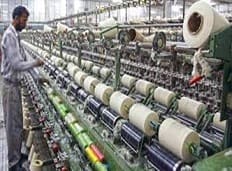With the shut down of manufacturing units , supply of raw material and delayed in the flow of payment , due to covid – 19, like other sectors– the textile and clothing sector is also going through a tough time.
According to the report of Clothing and Manufacturers Association of India (CMAI), a great loss in the form of recession is going to happen in the sector of textile .it estimates about a job loss of one crore workers.This type of horror estimation in textile and clothing sector is not given first time in this country. It was already happened in August 2019, where the North India Textiles Mills Association released its report in which they highlighting the issue of worst financial phases of the decade in the textile spinning industry with exports of cotton yarn plummeting about 50% in the month of April 2019 as compared to the previous year. The blows of demonetisation, haphazard introduction of GST regime and the 2008 financial crises, all of these were the factors responsible for rough patches in the textile sector for past few years.
What are the other reasons for the challenges to the sector? First and foremost, the advent of technology has rendered artisans and their skills outdated. Once famed across the globe as ‘artisans’ who were weaving delicate and dexterous yarn, ‘workers’ have now become one of the biggest concerns of Indian textile manufacturing enterprises.
Secondly, the globalised world has necessitated cost-competitiveness in the textile and clothing manufacturing processes. ‘Economies of scale’ has become the magic formula for nations like China, Bangladesh and Vietnam. According to Indian Ministry of Textiles’ Annual Report of 2018-19 this has resulted in a setback for the largely fragmented textile and clothing value chain in India which produces 70% of its output from small and medium scale industries.
Lastly, handloom and handicraft artisans are facing a perpetual lack of market linkage and branding. In such a situation, the artisans are not getting reasonable returns on their efforts.
Before suggesting some of the solutions, it is crucial to assess the current policy discourse adopted by the Government of India to facilitate the sector. The Ministry of Textiles enlists a plethora of schemes in place for different segments of the textile sector. Be it the Technology Upgradation Fund Scheme (TUFS) or the Powertex scheme for powerlooms or the Scheme for Integrated Textile Park (SITP), the government’s efforts are inclined towards using finance to generate attributes of productivity, efficiency, exportability, scalability and marketability of the textile products in India.
However, what seems to be missing is an outward looking approach to address the external factors affecting the sector.
The first factor is the raw material for textile manufacturing processes. While the global demand of clothing is inclined towards man-made fibre over cotton, India’s production still remains cotton-dominated. In man-made fibre segment, particularly polyester related raw materials, including PTA and PSF, the initial production costs of these materials are significantly higher as compared to other countries like China. Until recently, India used antidumping duty to protect the very few such domestic manufacturing oligopolies. This has fortunately been stopped. In any case, there is an urgent need to infuse efficiency into the domestic manufacturing of all raw materials, whether synthetic or cotton.
The second factor is of financial costs, which have a direct impact on the viability of the textile enterprises. For both handlooms and powerlooms, credit support to start business and working capital support to run their businesses is extremely critical. Also, the MSME clusters as an entity needs banking assistance to leverage their manpower skills and compete with the large corporates operating at economies of scale.
The third factor is infrastructure, in particular power and logistics. Being a power intensive industry, textile mills incur a significant proportion of their costs as electricity bills. A sustainable solution in this regards is to structurally reform the power sector, reducing losses, rationalising tariffs and passing on the efficiency gains to end-consumers. In case of logistics, regulatory and infrastructural bottlenecks in the freight transportation sector remains an issue affecting all manufacturing sectors including textile and clothing.
The fourth factor is market linkage. For handlooms and handicrafts, there is a tremendous scope for using e-commerce and fintech solutions to solve the problem of lack of market. This has to go hand to hand with effective advertising and branding support from the government and other agencies including National Institute of Fashion Technology and various textile promotion councils.
Lastly, there is a need to bring back the value for the worker in the modern textile industry as it was in the traditional era. Effective skill development and capacity building is indispensible for achieving this. Revamping the existing research-cum-training agencies to develop specialised state capacity for skill training is the first step in this regard. In addition to it, on the job skill training is vital to adapt to the changing nature of work on the factory floor. With automation now creeping in processes like zari and embroidery as well, there is a need to calibrate the skill requirements in alignment with such developments. This value creation for workers can potentially catalyse the ongoing efforts to provide a universal social safety net, safe working environment and decent income levels.

